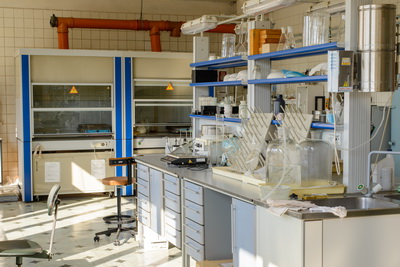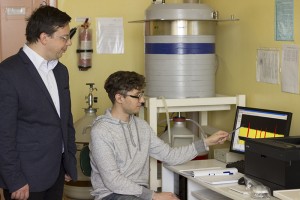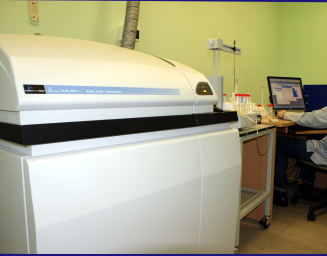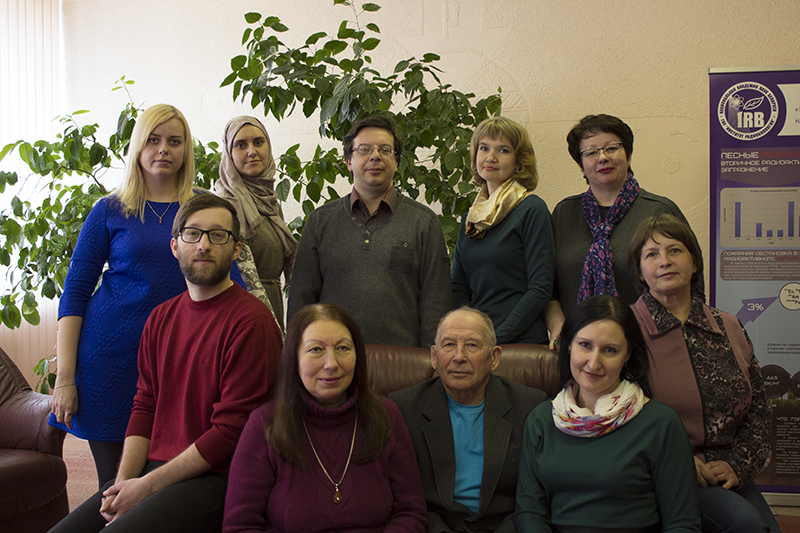The Laboratory of Radioecology is engaged in research of behavior of natural and man-made radioisotopes in natural and agricultural ecosystems. The main tasks of the laboratory are the analysis of migration Chernobyl-released radionuclides and their transfer in food chains, the assessing exposure to ionizing radiation biota and humans, as well as the development of methods for reducing the bioavailability of pollutants and remediation of territories disturbed by industrial activity.
The Laboratory of Radioecology is developing combined biologically active soil-improving additives for the rehabilitation of contaminated and disturbed soils, as well as improving the efficiency of farming on them. Forecast of radionuclides and heavy metals behavior in the soil-plant system under the climate changes is developed in the laboratory. Ways to increase the resistance of plants to the stressors based on their exposure to the electromagnetic fields with mm-wavelength are investigated.
Scientists of the laboratory explore the processes of spatial redistribution and transformation of physical and chemical forms of man-made radionuclides in soils and waters in the exclusion zone of Chernobyl NPP. New methods for assessing exposure doses of ionizing radiation on plants and animals inhabit natural ecosystems in the Polesye State Radiation Ecological Reserve are developed in the laboratory, and software for processing radiation measurement data and solving radiation safety problems are created here.
The Laboratory of Radioecology has all the necessary facilities for investigation in the field of radioecology: from sampling to radiochemical analysis and spectrometry measurements. The premises of the laboratory meet modern requirements of radiation safety standards.
Head
Aleksander NIKITIN, PhD AgriScs
Staff
GUZEVA Galina, lead researcher, PhD AgriScs
LASKO Tamara, researcher
TAGAI Svetlana, researcher
LEFERD Galina, researcher
SHURANKOVA Olga, researcher
SUKHAREVA Diana, researcher
SPIROV Ruslan, researcher
TANKEVICH Elena, junior researcher, PhD student
MISHCHENKO Egor, junior researcher, PhD student
SIMONCHIK Yulia, junior researcher
ZHUKOVSKAIA Evgeniia, junior researcher
ARENDAR Svetlana, 2nd category engineer
History
Established in 2002 following the move of Institute of Radiobiology from Minsk to Gomel by the fusion of four structural units: Aerial Radioecology lab, Water Radioecology lab, Dosimetry & Radiometry team and Toxicology team. Original researchers of the newly established laboratory were those who had significantly contributed, collectively and individually, to tackling emergency problems of post-Chernobyl recovery.
Until 2003, the lab was headed by its founder V. Mironov, Candidate of Chemical Sciences. During 2003–2009, leaded by V. Kudriashov, Candidate of Biological Sciences, and in 2009–2011 by V. Knatko, Candidate of Physics and Mathematics.
Present time
Our current research efforts highlight the following scientific and scientific-practical objectives:
- discovery of the physiological regulation mechanisms of the uptake of technogenic radionuclides and heavy metals by plants;
- development of remediation methods for technogenically disturbed lands;
- improvement of spectrometry data processing techniques with a low signal-to-noise ratio.
The lab develops combined-effect biologically active soil-improving additives (soil conditioners) to remediate technogenically disturbed lands and make agricultural practices on them possible or even more advanced.
Part of our research is focused on studying the behaviours of radionuclides and heavy metals in soil-to-plant systems under the changing weather and climate conditions.
Many of our research activities are done in the Chernobyl exclusion zone’s Polesye State Radiation-Ecological Reserve. There, for instance, we study the processes of spatial redistribution and transformation of physical and chemical forms of mad-made radionuclides in soil and water environments; work out new methods to evaluate exposure doses to plants and animals in their natural habitats, develop special software tools to process the measurement data and deal with the tasks of radiation protection.

The laboratory is sufficiently equipped with the modern measuring instruments and has all the means to carry out high-quality analytical research in the field of radioecology, from sampling and sample preparation to radiochemical analysis and spectrometry measurements. Laboratory premises comply with the existing radiation safety requirements.

We use this semiconductor gamma-detector-equipped spectrometry unit to measure radioactive isotopes (Am-241, Ba-133, Co-57, Co-60, Cs-137, Eu-152, Ir-192, Mn-54, Na-22, Se-75, Th-228, Cr-51, Ga-67, I-123, I-125, I-131, In-111, Tc-99m, Tl-201, Xe-133, K-40, Ra-226, Th-232, U-238 etc.) in water, soil, food, biomedical, aerosol filters and other samples. It is complimented by AT1320C Gamma Activity Monitor – a spectrometric scintillation (NaI(Tl) detector) gamma activity monitor used for measuring volumetric (specific) radionuclide activity of Сs-137 and К-40 in environmental samples.

This is a quadrupole mass analyzer, manufactured by Perkin Elmer, intended for the element and isotope analysis of liquid samples, with practically an all-element range: metals, non-metals (excl. N and O gases), lanthanides, actynoides, including the near transuranic elements and Tc-99, U-233, 234, 236, Th-230, isotopes of Pu and Np. Good for measuring ultra low concentrations of isotopes (10-6–10-9) to the main isotope.
To measure the content of toxic and explosive gases in the air, we use a multi-channel gas analyzer Drager X-am 7000. This device is equipped with sensors for determining hydrogen sulphide (up to 100 ppm), hydrogen cyanide (up to 50 ppm), ammonia (up to 200 ppm). The sensors have fast response, high accuracy and low cross sensitivity.
Ultra high frequency generators are used to study physiological and biochemical reactions of plant organisms to electromagnetic radiation.
A special climate-controlled phyto-room is used for our controlled vegetation experiments.
Apart from that, the lab hosts a range of equipment for sampling and sample preparation (microwave sample extraction system, ovens, muffle furnaces, mills, etc.), radiation monitoring (dosimeters, radiometers, etc.), chemical analyses (potentiometers with electrode sets, vacuum pumps, sand baths, shakers, pure water system, etc.).
Current projects
- Assess the effects of inter-annual variance of hydrological and temperature conditions on physicochemical forms of radionuclides and heavy metals in soils and on their accumulation by plant organisms (State Research Programme “Environment and Natural Resources”);
- Assess the levels of radioactive contamination of the main forest trees in highly contaminated areas and the wood’s correspondence to the Republican Permissible Levels, evaluate contribution of wood contamination to the total contamination levels of forest fuel materials (Joint Actions Programme of the Union State of Russia and Belarus on Protection of the Public and Territories Affected by the Chernobyl NPP Disaster);
- Study deep neural networks in automated measurements of low activities of radionuclides in samples (Research Grant BRFFR-RFFR-2020);
- Development of new remediation methods for radionuclide contaminated territories with the use of efficient microbial technologies (IRB-EMRO Cooperation Agreement, Japan);
- Study accumulation and migration of radionuclides from atmospheric fallouts in boggy ecosystems in European Subarctic Regions of Russia and Belarusian Polesye (Research Grant BRFFR-RFFR-М)
Publications
- Kalinichenko, S.A. Spatial Distribution of 90Sr in the Ecosystems of Polesye State Radiation-Ecological Reserve / S.A. Kalinichenko, A.N. Nikitin, I.A. Cheshyk, O.A. Shurankova // Strontium contamination in the environment / eds. P. Pathak, D.K. Gupta. – Cham: Springer International Publishing, 2020. – P. 121-140.
- Чешик, И. Новые почвоулучшающие добавки для загрязненных радиоактивным цезием земель (Novel soil conditioners for cesium-contaminated lands, in Russian) / И. А. Чешик, А. Н. Никитин // Наука и инновации. 2019. – №3. – С.21–25. https://doi.org/10.29235/1818-9857-2019-3-21-25
- Калиниченко С.А. Особенности латерального перераспределения 137Cs, 90Sr, 241Am в поверхностном слое почвы геохимически сопряженных ландшафтов при значительном для белорусского Полесья перепаде высот (Specific features of lateral redistribution of 137Cs, 90Sr, 241Am in the topsoil of geochemically linked landscapes in significant elevation differences typical for Belarussian Polesye, in Russian) / С. А. Калиниченко, Ю. И. Бондарь, А. Н. Никитин, В. Е. Белаш, А. А. Баленок // Известия Гомельского государственного университета имени Ф. Скорины. – 2019. – Т. 114, № 3. – С. 29–35.
- Nikitin, A.N. Impact of effective microorganisms on the transfer of radioactive cesium into lettuce and barley biomass / A.N. Nikitin, I.A. Cheshyk, G.Z. Gutseva, E.A. Tankevich, M. Shintani, S. Okumoto // Journal of Environmental Radioactivity. – 2018. – Vol. 192. – p. 491–497. https://doi.org/10.1016/j.jenvrad.2018.08.005.
- Спиров, Р.К. Конверсионные дозовые коэффициенты трансурановых элементов для растений зоны отчуждения Чернобыльской АЭС (Conversion dose coefficients of transuranium elements for plants in the exclusion zone of the Chernobyl NPP, in Russian) / Р.К. Спиров, А.Н. Никитин // Медико-биологические проблемы жизнедеятельности. – 2018. – Т. 20, № 2. – С. 52–57.
- Nikitin, A. Influence of electromagnetic radiation of extremely high frequency on sensitivity of plants to cold stress [Electronic resource] / A. Nikitin, D. Suhareva, E. Mishchenko, A. Zubareva, O. Shurankova, R. Spirov // IEEE Xplore Digital Library. – IEEE, 2018. DOI: 1109/ELMECO. 2017. 8267732
- Никитин, А.Н. Содержание 137Cs, 238Pu, 239+240Pu и 241Am в экспериментах диких копытных животных, обитающих в зоне отчуждения Чернобыльской АЭС (Concentrations of 137Cs, 238Pu, 239+240Pu and 241Am observed in experiments on wild hoofed animals in the exclusion zone of the Chernobyl NPP, in Russian) / А.Н. Никитин, О.А. Шуранкова, И.А. Чешика, С.А. Калиниченко, Р.А. Король // Радиационная биология. Радиоэкология. – Т. 58, № 2. – С. 166–173. DOI: 7868/S0869803118020054
- Nikitin, A.N. Potential of Biochar as a Measure for Decreasing Bioavailability of 137Cs in Soil / A.N. Nikitin, O.A. Shurankova, O.I. Popova, I.A. Cheshyk, R.K. Spirov // Remediation Measures for Radioactively Contaminated Areas / ed: D. Gupta, A. Voronina. — Springer, Cham., 2018 – p. 113—137. https://doi.org/10.1007/978-3-319-73398-2_6.
- Kalinichenko, S. A. The Behavior of 90Sr in Macrophytes Inhibiting Water Reservoirs in the Belarussian Sector of the Chernobyl NPP Exclusion Zone. // S.A. Kalinichenko, A.N. Nikitin, I.A. Cheshyk, O.A. Shurankova // Behaviour of Strontium in Plants and the Environment / D. K. Gupta & W. Clemens (Eds.). – Springer, 2018. – P. 125–144. https://doi.org/10.1007/978-3-319-66574-0_9
- Зубарева, А.В. Фильтроадсорбционная очистка загрязненных долгоживущими радионуклидами водоемов (Filter-adsorption cleaning of the water bodies polluted by long-lived radionuclides, in Russian) / А. В. Зубарева, А.Г. Кравцов, С.В. Зотов // Научный журнал Академии ГПС МЧС России «Пожары и чрезвычайные ситуации: предотвращение, ликвидация» // Москва, Россия. – 2017. — № 3. – С. 64–68.
- Спиров, Р.К. Аккумуляция трансурановых элементов надземными и подземными органами сосудистых растений (Accumulation of transuranium elements by underground and aboveground organs of tracheophytes, in Russian) / Р.К. Спиров, А.Н. Никитин, И.А. Чешик, Р.А. Король // Доклады НАН Беларуси. – 2017. – Т. 61, № 2. – С. 51–57.
- Спиров, Р.К. Оценка дозовой нагрузки трансурановых элементов на отдельные виды биоты Полесского государственного радиационно-экологического заповедника (The assessment of radiation exposure of transuranium elements on some species of the biota of Polesie State Radioecological Reserve, in Russian) // Р.К. Спиров, А.Н. Никитин // Проблемы здоровья и экологии. – 2017. — № 4. – С. 52–57.
- Чешик, И.А. Влияние микробиологических препаратов ЕМ-1 и EMX-Gold на биокинетику 137Cs в организме лабораторных животных (Impact of microbiological preparations EM-1 and EMX-Gold on biokinetics of 137Cs in the laboratory animals, in Russian) / И.А. Чешик, А.Н. Никитин, Д.В. Сухарева и др. // Известия Национальной академии наук Беларуси. Серия медицинских наук. – 2017. – № 1. – С. 45–53.
- Чешик, И.А. Перспективы использования микробиологических препаратов для снижения радиационных рисков (The potential of using microbiological preparations to reduce radiation-associated risks, in Russian) / И.А. Чешик, А.Н. Никитин, Д.В. Сухарева и др. // Наука и инновации. – 2017. – Т. 171, № 5. – С. 64–67.
- Cheshyk, I. Impact of microbiological preparations on radioactive cesium excretion rate under condition of its chronic ingestion / I. Cheshyk, D. Suchareva, A. Nikitin // RAD Conference Proceedings. – 2017. – Vol. 2. – P. 64–69. DOI: 21175/RadProc.2017.14
- Gaponenko, V.I. A comparative study of 40K versus 137Cs uptake as chemical analogs by vegetable plants at different concentrations of these nuclides in soil near the 30-km Chernobyl zone / V.I. Gaponenko, N.V. Shamal, A.N. Nikitin // Radioprotection 51(1), 25-30 (2016), 25-30
- Спиров, Р.К. Нейронные сети в спектрометрии радиоактивных излучений: состояние проблемы (Neural networks in spectrometry of radioactive radiations: the problem condition, in Russian) / Р.К. Спиров, А.Н. Никитин // Экологический вестник. Научно-практический журнал, 2016. – № 1(35). – С. 124-128.
- Bondar Yu.I., Navumau A.D., Nikitin A.N., Brown J., Dowdall M. Model assessment of additional contamination of water bodies as a result of wildfires in the Chernobyl exclusion zone // Journal of Environmental Radioactivity. – 2014. – Vol. 138. – P. 170–176. https://doi.org/10.1016/j.jenvrad.2014.08.018
- Конопля Е.Ф., Миронов В.П., Журавков В.В. Радиация и Чернобыль: короткоживущие радионуклиды на территории Беларуси (Radiation and Chernobyl: Short-lived radionuclides in Belarus, in Russian). – Минск: Белорусская наука, 2008. – 199 с.
- Гапоненко В.И., Конопля Е.Ф. Радиация и Чернобыль: Состояние, хлорофилл и защита растений (Radiation and Chernobyl: Plants State, Chlorophyll and Protection, in Russian). – Гомель: РНИУП «Институт радиологии», 2007. – 266 с.
- Конопля, Е.Ф., Кудряшов В.П., Миронов В.П. Радиация и Чернобыль: Трансурановые элементы на территории Беларуси (Radiation and Chernobyl: Transuranic Elements in Belarus Territory, in Russian). – Минск: Белорус. наука, 2006. – 191 с.
- Ryabokon N.I., Smolich I.I., Kudryashov V.P., Goncharova R.I. Long-term development of the radionuclide exposure of murine rodent populations in Belarus after the Chernobyl accident // Radiat Environ Biophys, 2005 – P. 169-181. DOI: 1007/s00411-005-0015-2
- Mironov V.P., Matusevich J.L., Kudrjashov V.P., Ananich P.I Determination of uranium concentration and burn-up of irradiated reactor fuel in contaminated areas in Belarus using uranium isotop ratios in soil samples // Radiochimica Acta, 2005. — № 93. – С. 781-784.
Contacts:
E-mail: radioecology@irb.basnet.by
Tel.: +375-232-68-20-35
